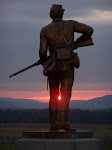In this post, we are going to take a brief break from the Battle of Gettysburg and head to another famed Civil War site about an hour's drive south: Antietam National Battlefield. Some of us former and current Gettysburg folks headed down for Thursday and had a great time. Pictured here from left to right is Ranger Chris Gwinn, Interpreter Nick Lorenz, Ranger John Hoptak, and myself. Also ran into Rangers Mannie Gentile and John Nicholas during the course of the day. A good time was had by all. Met lots of great people who interpret the battle at Sharpsburg.

We first headed to the Pry House Field Hospital and Museum, seen here in a post-war view. This site was used as Gen. George B. McClellan's headquarters on September 17, 1862 as he viewed the fighting to the west (left). It was quickly converted into a field hospital. Here, Gen. Joseph Hooker's wounded foot was personally treated by medical mastermind Jonathan Letterman. Wounded Gen. Israel Bush Richardson was also taken here after he was wounded by Confederate shrapnel. Winfield Hancock at that time assumed command of Richardson's command. Unfortunately, Richardson died in the upper right room seen here in November of 1862. Click to enlarge. Notice the small trap door near the second right chimney to the rear. Supposedly, McClellan and his staff used this hatch to watch parts of the battle. This door too is still there.

The barn next door is a witness to the battle as well. It also served as a field hospital. Chris showed us something cool here. On this foundation stone, you can see where one of the Pry Family members carved their name into the rock. The Pry's were descendants of Huguenots and at one time changed their name from Bry to Pry. This home and barn changed owners of the decades until the Park Service acquired it in 1961. Here at the barn, I met up with my good friend, Robby Burton, Education Specialist at the National Museum of Civil War Medicine. This organization operates a great museum at the Pry Farm. Robby showed us some really cool stuff as well.
Our view that history continues to prepare people for the future was reinforced during out visit. Medical staff of our modern military were visiting the Pry Farm to learn more about battlefield medicine and its applications in the modern world via those same implements first utilized at this field hospital.
Our view that history continues to prepare people for the future was reinforced during out visit. Medical staff of our modern military were visiting the Pry Farm to learn more about battlefield medicine and its applications in the modern world via those same implements first utilized at this field hospital.

In the afternoon, we joined Ranger Hoptak for a two and a half hour tour of some major parts of the battlefield. To the far left was the scene of the fierce fighting in the Miller Cornfield.

The cornfield, currently filled with Soy Beans, was utterly destroyed on September 17, 1862. Joseph Hooker noted how not one stalk of corn was left standing, and that the rows of the dead lay in perfect lines as if still in formation. By the end of the morning, the combined fighting in the North Woods ( far background), Cornfield (foreground), and the West Woods (extreme left), left over 12,000 casualties between both sides.

Attacks continued on the Confederate-held Sunken Road to the south, including a frontal assault by the famed but tattered Irish Brigade. This road was formed long before the war by wagons eroding this path in order to evade a toll charge for an adjoining road. It made for a great defensive position for Confederates. John B. Gordon commanded a segment of the troops here. Gordon was wounded five times in this road...and lived another forty years after surviving the rest of the war.

This Alexander Gardner photo was taken in the approximate location of my own photo. Antietam's aftermath was the first in history to be recorded in such a way. Over 5,000 men became casualties in the fighting over this contested road. The southern dead in the road itself were two or three deep in many places. It has been known as "Bloody Lane" ever since.

A panoramic photo I took of the Sunken Road looking north, vantage point of the approaching Federals.
In our first video, John stands up above Burnside Bridge. Here, John tells us the importance of Robert E. Lee defending the flanks of his army. This area was a key anchor to that defense.

This bridge is over 170 years old. If rock could talk. The huge tree on the rear-left side of the bridge was here during the battle.
In this video, John tells us of Ambrose Burnside's attack across the bridge and his push forward after securing the bridge and slope. During the course of our program, some young Yankees charged us from across the bridge...

The last photo of the day I took. This view looks west over the battlefield towards the western mountain ranges. Note the observation tower at left, which stands above the Sunken Road.
Special thanks to Rangers John Hoptak and Chris Gwinn for showing Nick Lorenz and I around on Thursday!
Special thanks to Rangers John Hoptak and Chris Gwinn for showing Nick Lorenz and I around on Thursday!









No comments:
Post a Comment